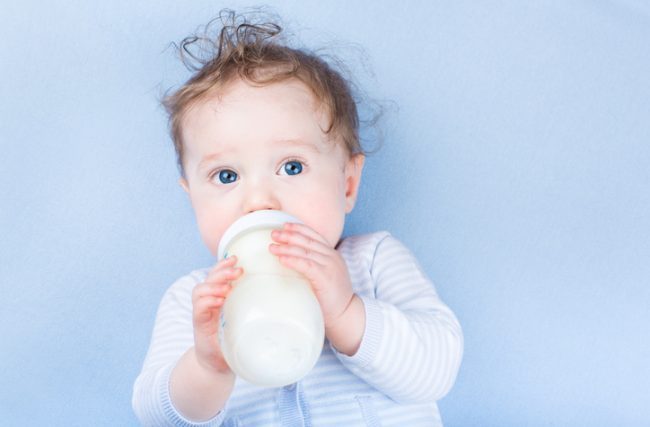For parents, some amazing bonding moments come during feeding time. Whether you choose to bottle feed baby formula or need to bottle feed breast milk, you need to protect your newborn’s delicate immune system by properly washing and sterilizing bottles.
Before using your bottles
Before purchasing new plastic baby bottles, check to see if they are BPA-free. BPA and other chemicals can often be found in plastics and these chemicals can seep into breast milk and formula when the bottles are heated up. Some studies[1] [2] [3] indicate that BPA exposure in infants can be harmful to their health and development. Do some research and decide what’s best for your family before you make a purchase.[4]
Before using your bottles for the first time, be sure to sterilize the bottle and all of its components before feeding your baby.[5] Just because a bottle is brand new doesn’t mean that it is clean and ready to go. Take the extra precaution for your peace of mind and, most importantly, for your baby’s health.
How do I clean my baby’s bottles?
There are a few different methods for cleaning bottles, but no matter which you choose, you always want to be sure to break the bottle down into as many pieces as possible. Bacteria will thrive on any dried milk left on the bottle, so getting into all of the nooks and crannies of the bottles is imperative.[6]
There are also specialized tools available to help you wash your bottles. Consider purchasing a bottle nipple brush, a regular bottle brush, and a bottle drying rack. You’ll want to keep these items clean as well and should only use them on bottles, not on your regular dishes.[7]
Wash bottles in the dishwasher
This is a simple solution for parents if you own dishwasher-safe bottles. It’s best to clean all of the bottle components on the top rack of your washer for a gentler wash. Dishwasher bottle baskets can also be purchased so the bottle pieces stay in place on the top rack.
Wash bottles by hand
The steps for washing bottles by hand are as follows:
- Prepare a washing solution – in a clean sink, fill with hot water and a dab of mild dish soap.
- Scrub – using your various bottle brushes, rid all bottle pieces of dried milk and formula.
- Rinse – use cold water to rinse the bottles of all soap suds and residue.
- Dry – place the bottles on a drying rack and allow them to air dry, which is the preferred way to dry bottles.
Wash bottles while traveling
There’s a great travel hack that actually means you don’t need to wash them at all. When you’re traveling, consider using bottle liners to save yourself the hassle of a thorough cleaning. However, you still must take time to properly wash the nipple, closure and cap of the bottle. There are also travel bottle cleaning brush sets that you can purchase to make cleaning a breeze when you’re away from home.[8]
Bottle washing tips
Sometimes, a hand wash is not enough to remove smells or stains from your bottles. Here are some additional washing tips for your baby bottles.[9]
- Deodorize your bottles with a teaspoon of baking soda and half a bottle of hot water. Shake vigorously and wash after. Soak overnight for persistent smells.
- Remove juice smells by filling the bottle with vinegar and soaking overnight.
- Mostly avoid smells in your bottles by switching from plastic bottles to glass bottles.
How do I sterilize my baby bottles?
There are 3 main methods for sterilizing baby bottles.[10] Bottles do not need to be sterilized after each use, but you should sterilize your bottles, nipples, and caps before the first use.[11] It’s a good idea to sterilize the bottles more often if your baby is sick.
Ways to sterilize baby bottles
- Boiling – this is the traditional method where bottles are placed in boiling water for about 15 minutes.
- Sterilizing solutions – using a bucket, cold water, and a sterilizing solution, place bottles in the solution and soak for 30 minutes.
- Steaming – There are steaming devices that you place in the microwave with the bottle pieces and water. There are also stand-alone electronic devices available. Each option is quick and hassle-free.
Clean bottles and a well-fed baby make for happy parents! Share any bottle cleaning advice or product recommendation with other parents in the comments below.
[1] National Institute of Environmental Health Sciences. Bisphenol A (BPA).
[2] U.S. Food and Drug Administration. (2014, November). Bisphenol A (BPA): Use in Food Contact Application.
[3]vom Saal, F. S., Akingbemi, B. T., Belcher, S. M., Birnbaum, L.S., Crain, D. A., Marcus Eriksen, M., … Zoeller, R. T. (2007, July 27). Chapel Hill bisphenol A expert panel consensus statement: Integration of mechanisms, effects in animals and potential to impact human health at current levels of exposure.
[4] National Institute of Environmental Health Sciences. (2016). NIEHS-supported Bisphenol A Research Articles.
[5] Marcason, W. (2015, February 18). How to Safely Clean Baby Bottles.
[6] Marcason, W. (2015, February 18). How to Safely Clean Baby Bottles.
[7] Adler, L. C. (2015, May 11). Buying and Caring for Baby Bottles and Nipples.
[8] Miller, J. (2015, June 10). How to wash and clean your baby bottles and sippy cups.
[9] Miller, J. (2015, June 10). How To Remove Smells From Baby Bottles And Sippy Cups.
[10] Ohio State University Wexner Medical Center. (2013, May 22). How to Sterilize Baby Bottles
and Nipples.
[11] Marcason, W. (2015, February 18). How to Safely Clean Baby Bottles.

